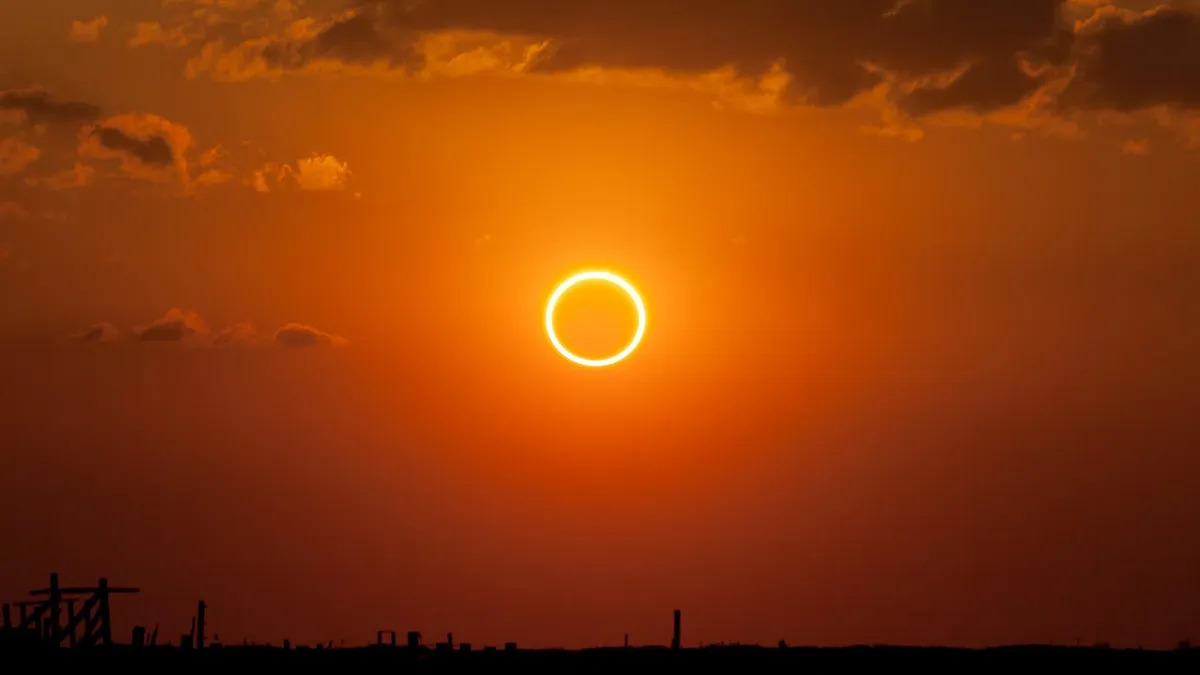Rare Ring Of Fire Eclipse Soon Visible In US
Get ready for the rare ring of fire eclipse set to captivate the U.S. skies. Ensure safety with expert tips and embrace this celestial wonder.
Author:Hajra ShannonReviewer:Paula M. GrahamOct 12, 2023792 Shares43.9K Views

The United States is gearing up for a celestial event of a rare ring of fire eclipsethis weekend. The "ring of fire" annular solar eclipse will grace the skies, making it a must-see event for stargazers and the general public alike.
A Phenomenon In The Making
As shared by Allie Yang, National Geographic editor and space expert, the event is set to occur on Saturday and will be visible not only in the U.S. but also in Central and South America. Specifically, the eclipse will cross through several Western states, including "Oregon, Nevada, Utah, New Mexico, Texas and some parts of California, Idaho, Colorado, and Arizona."
Though annular solar eclipses are not necessarily rare, Yang highlighted its significance, stating that it is "uncommon for the eclipse path to cross the U.S." This phenomenon last illuminated U.S. skies back in 2012.
Precautions And Safety
Safety remains paramount, especially for an event as tempting as this. Yang emphasized the dangers of viewing the eclipse without proper precautions, warning, "Even a sliver of sun, as we’ll see in this year’s eclipse, will scorch your eyes, especially because your pupils are dilated in the relative darkness. Irreversible damage can happen in seconds."
Yang urged enthusiasts to wear ISO-certified eclipse glasses or adopt indirect viewing methods, such as pinhole projection.
Beyond The Visual Experience
However, eclipses aren't just a visual treat. They offer a "totally multisensory experience," Yang explained. "If you’re outside, you might hear nighttime animals come out. You may feel the coolness of the sun being blocked, and its warmth returning as the moon passes the sun." Radio hobbyists might detect changes in radio frequencies due to the eclipse's effects on the ionosphere. Yang elaborated on its significance, "This is where radio and GPS signals travel, so both can be affected in an eclipse."
Further diving into the scientific implications of the eclipse, Yang shared that researchers are set to "measure changes to temperature, pressure, and ionization." She said, "Data gathered from this eclipse will help inform what research is done on April 8, 2024, when there will be a total eclipse."
Insights From A University Professor
Professor John Armstrong from Weber State University delved deeper into the nature of this celestial event. Describing the annular solar eclipse, he mentioned that the moon's elliptical orbit causes varying coverage of the sun. He explained, "To have an eclipse coming through someplace where we can see it is actually kind of rare."
Armstrong further detailed the timeline of the eclipse, revealing that the event would start around 9 a.m. on Saturday, reaching its peak at approximately 10:30 a.m., with the moon diminishing about 90% of the sun's light.
Viewing Spots And Suggestions
For those residing in Utah, Richfield is pegged as the prime viewing spot. Events such as the eclipse festival at Snow College's Richfield campus are already lined up to capitalize on this rare occurrence. The Utah Department of Transportation has cautioned about potential traffic surges, expecting around 300,000 visitors.
Armstrong offers handy tips for enthusiasts without eclipse glasses. "If you can find a leafy tree or bush where the leaves cross over each other, the shape of the sun can be seen in the plant's shadows due to pinholes created by the crossed leaves," he advised.
A Look Ahead
For those who miss this event, the next annular solar eclipse in Utah is forecasted for 2039. Armstrong also highlighted upcoming eclipses in other regions, with a total solar eclipse scheduled for Texas and the Midwest in 2023 and another in Luxor, Egypt, come 2027.
Eclipses In The World Of Science
Eclipses have also historically aided scientific pursuits. Armstrong shared a fascinating anecdote related to Einstein's theory of general relativity, which was corroborated during a total solar eclipse in 1919. The event allowed scientists to confirm the bending of light due to the sun's gravity, validating Einstein's predictions.
For more information and insights on this year's eclipse, visit natgeo.com.

Hajra Shannon
Author

Paula M. Graham
Reviewer
Latest Articles
Popular Articles